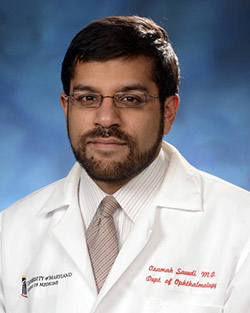April 27, 2022
Interim Chair and Vice Chair to Continue Forward Momentum of Longstanding Department
 UMSOM Dean E. Albert Reece, MD, PhD, MBA, announced today that two senior faculty members in the Department of Ophthalmology and Visual Sciences have been named to leadership positions.
UMSOM Dean E. Albert Reece, MD, PhD, MBA, announced today that two senior faculty members in the Department of Ophthalmology and Visual Sciences have been named to leadership positions.
Lisa S. Schocket, MD, Associate Professor of Ophthalmology and a leading expert in retinal diseases, has been appointed Interim Chair in the Department. She will assume her new position July 1 when Bennie Jeng, MD, MS, transitions from his current chairmanship here at the UMSOM. Additionally, physician-scientist and glaucoma specialist Osamah J. Saeedi, MD, MS, Associate Professor of Ophthalmology, has been named Vice Chair of the Department.
“As highly experienced and talented academic leaders, both Dr. Schocket and Dr. Saeedi are ideally suited for these positions,” said Dr. Jeng. “Our department has attracted national attention for its significant accomplishments and strong momentum in all areas of our mission, and I am confident that they will continue to maintain this strong upward trajectory, while opening new doors in clinical care, research, and education.”
Dr. Schocket is currently the Department’s Vice Chair for Clinical Affairs, Chief of Vitreoretinal Surgery, and Medical Director of the University of Maryland Eye Associates. She specializes in the medical and surgical management of retinal diseases, including diabetic retinopathy, age-related macular degeneration, retinal vascular occlusions, retinal detachments, macular holes, and cataract complications.
 After earning her medical degree at the University of Pennsylvania, Dr. Schocket completed her residency at the University of Pennsylvania/ Scheie Eye Institute, followed by a surgical retina fellowship at Tufts University/ Ophthalmic Consultants of Boston. Actively involved in research throughout her career, her papers have appeared in journals such as Ophthalmology, Archives of Ophthalmology, American Journal of Ophthalmology, and Retina. She is board certified in Ophthalmology and is a member of the American Society of Retina Specialists and the American Academy of Ophthalmology.
After earning her medical degree at the University of Pennsylvania, Dr. Schocket completed her residency at the University of Pennsylvania/ Scheie Eye Institute, followed by a surgical retina fellowship at Tufts University/ Ophthalmic Consultants of Boston. Actively involved in research throughout her career, her papers have appeared in journals such as Ophthalmology, Archives of Ophthalmology, American Journal of Ophthalmology, and Retina. She is board certified in Ophthalmology and is a member of the American Society of Retina Specialists and the American Academy of Ophthalmology.
“The Department of Ophthalmology boasts a highly coveted residency program with top-notch training, cutting-edge clinical care, a growing academic focus, and a collegial atmosphere,” said Dr. Schocket. “As a native of Baltimore and a long-time faculty member, I look forward to working with my colleagues to build upon these strengths and provide the very best care for our patients. I am honored to follow Dr. Jeng, who has been an exceptional leader, colleague, and friend to the faculty and residents as well as an ally to the community.”
Dr. Saeedi presently serves as the Department’s Chief of the Glaucoma Service and Director of Clinical Research. His ongoing research focuses on glaucoma, a leading cause of blindness that affects over 3 million Americans, and for which no cure currently exists. Specifically, his research efforts center on using new imaging techniques to develop sensitive biomarkers for glaucoma for early detection, which potentially could save the vision of patients with this disease, allowing them to continue to work and drive.
 Dr. Saeedi completed his medical degree and residency at the University of Texas – Southwestern Medical Center, followed by a glaucoma fellowship at the Wilmer Eye Institute of Johns Hopkins University. He also has a Master of Science in Epidemiology and Clinical Research. Dr. Saeedi is the recipient of an NIH Career Development Award (K23) and has grant funding from numerous other organizations, including the American Glaucoma Society. He received the prestigious Heidelberg Engineering Extreme Research Award—an international award for vision research—at the annual Association for Research in Vision and Ophthalmology (ARVO) conference in April 2018.
Dr. Saeedi completed his medical degree and residency at the University of Texas – Southwestern Medical Center, followed by a glaucoma fellowship at the Wilmer Eye Institute of Johns Hopkins University. He also has a Master of Science in Epidemiology and Clinical Research. Dr. Saeedi is the recipient of an NIH Career Development Award (K23) and has grant funding from numerous other organizations, including the American Glaucoma Society. He received the prestigious Heidelberg Engineering Extreme Research Award—an international award for vision research—at the annual Association for Research in Vision and Ophthalmology (ARVO) conference in April 2018.
“I am honored to serve in the role as Vice Chair for Academic Affairs and to help lead our department, particularly at this time of transition,” said Dr. Saeedi. “I also am grateful to Dean Reece and Dr. Jeng for their leadership, and look forward to working with our interim chair, Dr. Schocket.”
As the first established department for diseases of the eye in the U.S. in 1873, the Department of Ophthalmology and Visual Sciences has long been a leader in pioneering ocular care, including the creation of the modern-day ophthalmoscope and the first surgery to correct strabismus. In recent years, under Dr. Jeng’s guidance, the Department has made significant advances in clinical care, education, and research. The Department’s clinical footprint has expanded, its educational efforts are robust with many students electing to enter Ophthalmology, and its research portfolio has expanded substantially.
 “I am confident that Dr. Schocket and Dr. Saeedi will provide outstanding leadership to the Department of Ophthalmology during this interim period,” said Dean Reece, who is also Executive Vice President for Medical Affairs, UM Baltimore, the John Z. and Akiko K. Bowers Distinguished Professor, and Dean, University of Maryland School of Medicine. “As a team, they bring exactly the right combination of research, clinical, and academic leadership to move the Department forward.”
“I am confident that Dr. Schocket and Dr. Saeedi will provide outstanding leadership to the Department of Ophthalmology during this interim period,” said Dean Reece, who is also Executive Vice President for Medical Affairs, UM Baltimore, the John Z. and Akiko K. Bowers Distinguished Professor, and Dean, University of Maryland School of Medicine. “As a team, they bring exactly the right combination of research, clinical, and academic leadership to move the Department forward.”
About the University of Maryland School of Medicine
Now in its third century, the University of Maryland School of Medicine was chartered in 1807 as the first public medical school in the United States. It continues today as one of the fastest growing, top-tier biomedical research enterprises in the world -- with 46 academic departments, centers, institutes, and programs, and a faculty of more than 3,000 physicians, scientists, and allied health professionals, including members of the National Academy of Medicine and the National Academy of Sciences, and a distinguished two-time winner of the Albert E. Lasker Award in Medical Research. With an operating budget of more than $1.3 billion, the School of Medicine works closely in partnership with the University of Maryland Medical Center and Medical System to provide research-intensive, academic and clinically based care for nearly 2 million patients each year. The School of Medicine has nearly $600 million in extramural funding, with most of its academic departments highly ranked among all medical schools in the nation in research funding. As one of the seven professional schools that make up the University of Maryland, Baltimore campus, the School of Medicine has a total population of nearly 9,000 faculty and staff, including 2,500 students, trainees, residents, and fellows. The combined School of Medicine and Medical System (“University of Maryland Medicine”) has an annual budget of over $6 billion and an economic impact of nearly $20 billion on the state and local community. The School of Medicine, which ranks as the 8th highest among public medical schools in research productivity (according to the Association of American Medical Colleges profile) is an innovator in translational medicine, with 606 active patents and 52 start-up companies. In the latest U.S. News & World Report ranking of the Best Medical Schools, published in 2021, the UM School of Medicine is ranked #9 among the 92 public medical schools in the U.S., and in the top 15 percent (#27) of all 192 public and private U.S. medical schools. The School of Medicine works locally, nationally, and globally, with research and treatment facilities in 36 countries around the world. Visit medschool.umaryland.edu
Contact
Office of Public Affairs
655 West Baltimore Street
Bressler Research Building 14-002
Baltimore, Maryland 21201-1559
Contact Media Relations
(410) 706-5260
Related stories

Wednesday, June 05, 2024
Dr. Lisa S. Schocket Named Chair of UM School of Medicine’s Department of Opthalmology and Visual Sciences
University of Maryland School of Medicine (UMSOM) Dean Mark T. Gladwin, MD, announced today the appointment of Lisa S. Schocket, MD, as the new Chair of the Department of Ophthalmology and Visual Services at UMSOM. She is Associate Professor of Ophthalmology and Visual Sciences at UMSOM and has been serving as Interim Chair since July, 2022. The new appointment takes effect immediately.

Friday, December 03, 2021
UM School of Medicine Researchers Awarded $2 Million NIH Grant to Use Innovative Imaging to Study Causes of Glaucoma
Researchers at the University of Maryland School of Medicine (UMSOM) and US Food and Drug Administration (FDA) have received a nearly $2 million federal grant to conduct a clinical trial to help determine the pathway that leads to a common cause of blindness, primary open angle glaucoma. It will study how blood flow to the eye’s retina affects the onset and progression of the disease, which could eventually lead to new tests and treatments for the condition.

